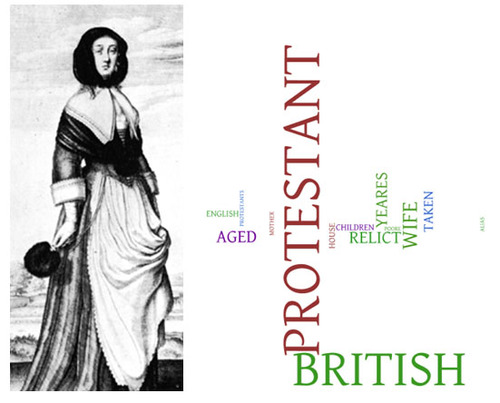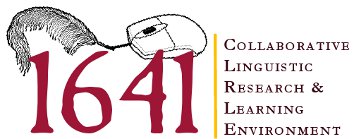Widows in the 1641 Depositions

The word widow, combined with the variants widowe, widow and widdowe, occurs 636 times in the Depositions. Many of its appearances are within opening statements, where female Deponents are described according to their place of residence, age and marital status. These opening statements often incorporate an explanation as to why a woman is testifying at all, and naturally this often involves the use of the item widow, as in the following extract.
In Extract 1 (see below), we see widdow being used to classify the deponent, much like the vast majority of occurrences of spinster, while late wife is used in a process of relational identification, possessivated and thus working to ‘signify the ‘belonging together’, the ‘relationality’ of the possessivated and possessing social actors’ (van Leeuwen, 1996:56).
A look at concordance lines for widow confirms that in the majority of cases it functions in this way – as a classifier, forming part of a closed set of details commissioners were required to collect for each deponent and named person. In other examples widow functions as late wife does in Extract 1: as a relational identifier, for example the widow of John Stanoway. Another lexical choice available for this type of representation is relict, which often appears as a relational identifier when widow has appeared as a classifier, as in Extract 2 (see below)
(Extract 1)
The Information of examinacion Jane Sanfford widdow late wife of Robert Sanfford of Crokcanedoeg in the parishe of Disert in the Barronye <of the Barronye> of ffassa and Dyninge in the Countye of Kilkennye taken this xvijth of Aprill 1644: who beinge duelye sworne and examined deposeth as followeth
(Extract 2)
Alice Clarke Late of Ardmulyan in the Countye of Meath widdowe, relict of Mr Samuell Clarke Late Deane of Clone Mc Nosh deceased.
However, there are a number of occurrences of widow that appear to be functioning somewhat differently:
(Extract 3)
This deponent was left a poore widdow with 7 children, 5 of them since this rebellion began died by occasion of it.
(Extract 4)
In Extracts 3 & 4 (above), as in numerous other examples throughout the data, the presence of the individuals’ status as widow, rather than forming part of a formulaic set of personal details, serves to construct them as victims in need of relief. This interpretation is supported by the presence of information pertaining to the deaths of children and of children being left fatherles [sic], as well as by the presence of the adjectives poore and robbed. Thus, the mentioning of an individual’s membership of the class widow invites an interpretation of them as powerless and deserving of assistance, contributing to what Cope (2001) has termed the ‘fashioning’ of victims.


